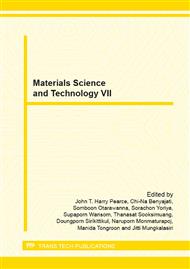p.143
p.148
p.153
p.158
p.163
p.173
p.177
p.182
p.188
Tribological Properties of PM Cu-Based Dry Friction Clutch
Abstract:
Sintered Cu-based frictional materials were developed by using powder metallurgy (PM) method. The materials are aimed for application in a passenger car as a dry friction clutch. Effects of sintering temperature and composition on mechanical and tribological properties were determined. It was found that improper frictional material formulations caused inferior properties, particularly when the sintering temperatures were increased. Admixing of high Sn content (8 wt. %) resulted in decreases of sintered density and hardness with increasing sintering temperature. High Sn contents caused swelling of the sintered materials. Tribological properties (friction coefficient and wear rate) of the sintered specimens of the investigated materials were insensitive to sintering temperatures in the range of 800-950 °C but they were strongly influenced by chemical compositions. Addition of 3 wt. % graphite lowered the friction coefficient, which subsequently lowered the wear rate of the sintered material. To increase friction coefficient, one of the crucial properties of the dry friction clutch, of the sintered Cu-based frictional materials, two approaches were employed. In the first approach, substitution of graphite by SiO2 powders could improve the material friction coefficient. In the second approach, decreases of graphite content from 3 to 1 wt. % and of Sn content from 8 to 2 wt. % were conducted. The latter approach not only improved friction coefficient but also improved sintered density and hardness of the Cu-based frictional materials.
Info:
Periodical:
Pages:
163-170
Citation:
Online since:
March 2013
Price:
Сopyright:
© 2013 Trans Tech Publications Ltd. All Rights Reserved
Share:
Citation:


